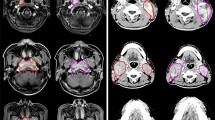Abstract
Purpose
To evaluate morphological and functional changes in the Bichat fat pad (BFP) after curative concurrent chemoradiotherapy in nasopharyngeal cancer (NPC) patients.
Methods
We retrospectively analyzed the volumetric, metabolic, and dosimetry parameters of BFPs in 7 NPC patients who underwent intensity-modulated radiotherapy (IMRT) between 2015 and 2020. Inclusion criteria were i) histologically confirmed diagnosis of NPC, ii) follow-up period of at least 12 months, iii) no history of previous irradiation or surgery in the maxillofacial area, and ìv) availability of pre- and posttreatment MRI and 18F‑FDG PET-CT performed in our Institution. All patients had stage III–IVA disease (n = 7) and received platinum-based chemotherapy. Planned doses in 30 daily fractions/5 days per week were 66 Gy (2.2 Gy/die 5 days/week) to the gross tumor volume, 66 Gy (2.1–2.2 Gy/die 5 days/week) to the gross nodal volume, 60 Gy (2 Gy/die 5 days week) to clinical target volume (CTV)1, and 54 Gy (1.8 Gy/die 5 days/week) to CTV2. All patients completed the planned radiotherapy course in a median time of 42 days (range 42–43). Relationships between BFP volumes and the following DVH parameters were evaluated: mean dose, maximum dose (Dmax), and percentage of BFP volume receiving more than 5 to 65 Gy (V5 to V65).
Results
The pre-RT volumes of the left and right BFPs were 12.24 cc (range 6.51–20.01 cc) and 11.55 cc (range 5.78–17.53 cc), respectively. The mean volumes of left BFPPRE and BFPPOST were 12.24 cc (range 6.51–20.01cc) and 13.85 cc (range 7.54–20.21 cc), respectively, with no significant statistical differences (P > 0.05). No statistically significant correlations were found between dosimetry features and BFP volumetric changes (all P > 0.05).
Conclusion
Our original results showed that chemoradiotherapy does not induce significant volumetric changes of the BFP. Further investigations are needed to evaluate the effects of higher radiation doses on BFP. This is the first real-world study on this issue.



Similar content being viewed by others
References
Tostevin PMJ, Ellis H (1995) The buccal pad of fat: a review. Clin Anat 8:403–406. https://doi.org/10.1002/CA.980080606
Bradley P (2011) Buccal pad of fat and its applications in oral and maxillofacial surgery: a review of published literature (February) 2004 to (July) 2009. Oral Surg 112:146. https://doi.org/10.1016/j.tripleo.2011.01.045
Peñarrocha-Diago M, Alonso-González R, Aloy-Prósper A, Peñarrocha-Oltra D, Camacho F, Peñarrocha-Diago M (2015) Use of buccal fat pad to repair post-extraction peri-implant bone defects in the posterior maxilla. A preliminary prospective study. Med Oral Patol Oral Cir Bucal 20:e699–706. https://doi.org/10.4317/medoral.20212
Mannelli G, Arcuri F, Comini LV, Valente D, Spinelli G (2019) Buccal fat pad: report of 24 cases and literature review of 1,635 cases of oral defect reconstruction. ORL 81:24–35. https://doi.org/10.1159/000494027
Dai T, Tian Z, Wang Z, Qiu W, Zhang Z, He Y (2015) Surgical management of osteoradionecrosis of the jaws. J Craniofac Surg 26:e175–179. https://doi.org/10.1097/SCS.0000000000001445
Nabil S, Ramli R (2012) The use of buccal fat pad flap in the treatment of osteoradionecrosis. Int J Oral Maxillofac Surg 41:1422–1426. https://doi.org/10.1016/J.IJOM.2012.04.001
Porcaro G, Amosso E, Mirabelli L, Busa A, Carini F, Maddalone M (2015) Osteoradionecrosis of the posterior maxilla: a new approach combining erbium: yttrium aluminium garnet laser and bichat bulla flap. J Craniofac Surg 26:e627–629. https://doi.org/10.1097/SCS.0000000000002136
Marx RE (1983) Osteoradionecrosis: a new concept of its pathophysiology. J Oral Maxillofac Surg 41:283–288. https://doi.org/10.1016/0278-2391(83)90294-X
Lyons A, Ghazali N (2008) Osteoradionecrosis of the jaws: current understanding of its pathophysiology and treatment. Br J Oral Maxillofac Surg 46:653–660. https://doi.org/10.1016/j.bjoms.2008.04.006
Chouikh F, Dierks EJ (2021) The buccal fat pad flap. Oral Maxillofac Surg Clin North Am. https://doi.org/10.1016/j.coms.2020.12.005
Tideman H, Bosanquet A, Scott J (1986) Use of the buccal fat pad as a pedicled graft. J Oral Maxillofac Surg 44:435–440. https://doi.org/10.1016/S0278-2391(86)80007-6
Merlotti A, Alterio D, Vigna-Taglianti R, Muraglia A, Lastrucci L, Manzo R et al (2014) Technical guidelines for head and neck cancer IMRT on behalf of the Italian association of radiation oncology—head and neck working group. Radiat Oncol 9:1–32. https://doi.org/10.1186/s13014-014-0264-9
Iatì G, Parisi S, Santacaterina A, Pontoriero A, Cacciola A, Brogna A et al (2020) Simultaneous integrated boost radiotherapy in unresectable stage IV (M0) head and neck squamous cell cancer patients: daily clinical practice. Rep Pract Oncol Radiother 25:399–404. https://doi.org/10.1016/j.rpor.2020.04.006
Cacciola A, Conti A, Tomasello F (2020) Big data analysis: the leap into a new science methodology. World Neurosurg 133:97–98. https://doi.org/10.1016/j.wneu.2019.04.268
Parisi S, Lillo S, Cacciola A, Santacaterina A, Palazzolo C, Platania A et al (2020) Vaginal mucosal melanoma: a complete remission after immunotherapy radiotherapy regimen (24 Gy/3 fractions/21 days). Folia Med 62:605–609. https://doi.org/10.3897/folmed.62.e49926
Nutting CM, Morden JP, Harrington KJ, Urbano TG, Bhide SA, Clark C et al (2011) Parotid-sparing intensity modulated versus conventional radiotherapy in head and neck cancer (PARSPORT): a phase 3 multicentre randomised controlled trial. Lancet Oncol 12:127–136. https://doi.org/10.1016/S1470-2045(10)70290-4
Gupta T, Sinha S, Ghosh-Laskar S, Budrukkar A, Mummudi N, Swain M et al (2020) Intensity-modulated radiation therapy versus three-dimensional conformal radiotherapy in head and neck squamous cell carcinoma: long-term and mature outcomes of a prospective randomized trial. Radiat Oncol 15:1–9. https://doi.org/10.1186/s13014-020-01666-5
Brouwer CL, Steenbakkers RJHM, Bourhis J, Budach W, Grau C, Grégoire V et al (2015) CT-based delineation of organs at risk in the head and neck region: DAHANCA, EORTC, GORTEC, HKNPCSG, NCIC CTG, NCRI, NRG Oncology and TROG consensus guidelines. Radiother Oncol 117:83–90. https://doi.org/10.1016/J.RADONC.2015.07.041
Gierloff M, Stöhring C, Buder T, Gassling V, Açil Y, Wiltfang J (2012) Aging changes of the midfacial fat compartments: a computed tomographic study. Plast Reconstr Surg 129:263–273. https://doi.org/10.1097/PRS.0B013E3182362B96
Author information
Authors and Affiliations
Corresponding author
Ethics declarations
Conflict of interest
A. Cacciola, S. Lillo, S. Parisi, C. Tamburella, A. Brogna, G. Ferini, A. Blandino, F. Minutoli, and S. Pergolizzi declare that they have no competing interests.
Additional information
Data availability statement
The data that support the findings of this study are available from the corresponding author upon reasonable request.
Rights and permissions
About this article
Cite this article
Cacciola, A., Lillo, S., Parisi, S. et al. Intensity-modulated radiotherapy does not induce volumetric changes of the Bichat fat pad in nasopharyngeal cancer. Strahlenther Onkol 198, 1002–1007 (2022). https://doi.org/10.1007/s00066-022-01974-7
Received:
Accepted:
Published:
Issue Date:
DOI: https://doi.org/10.1007/s00066-022-01974-7




